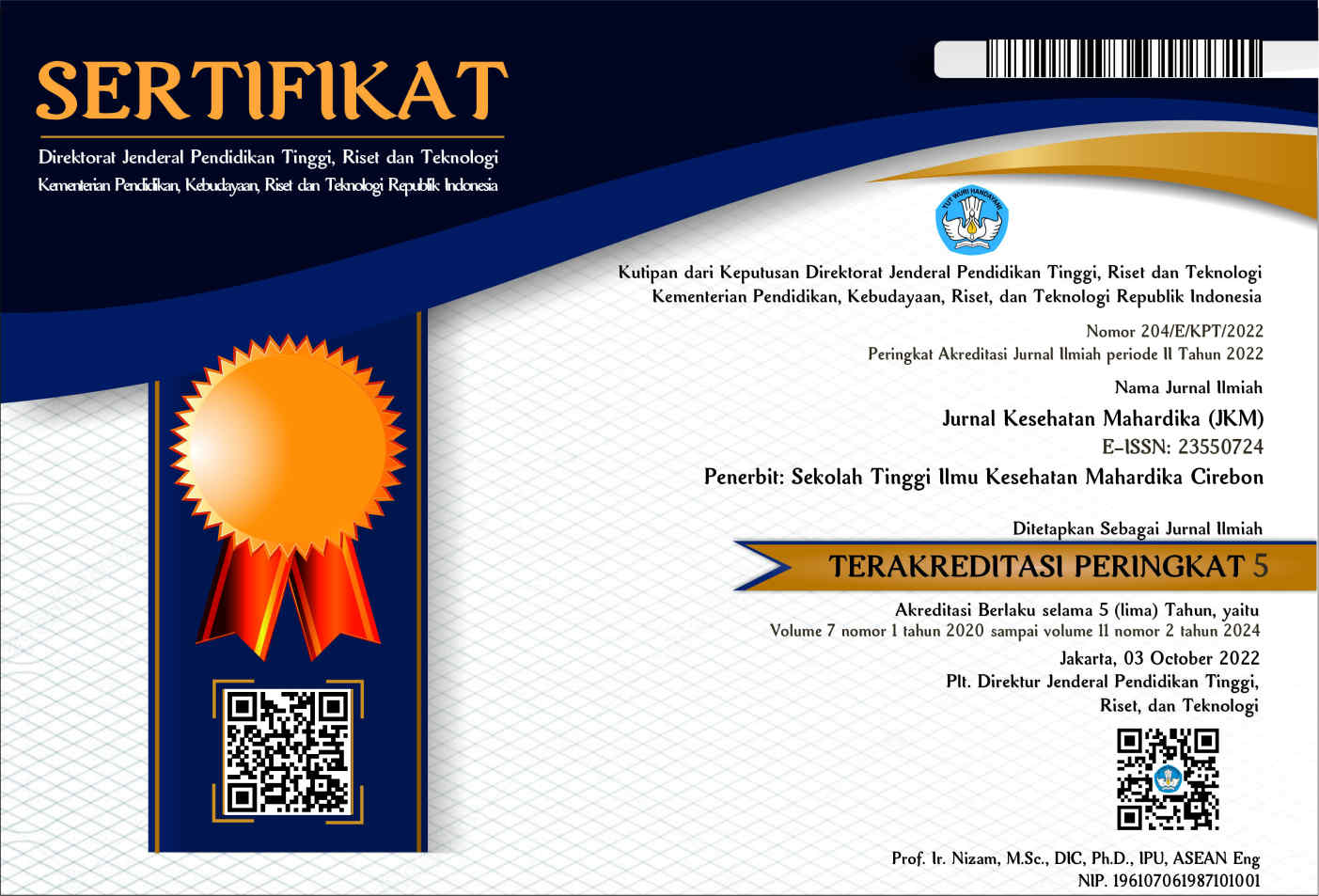The Correlate Between Environmental Sanitation Pollution Risk And Diarrhea of Balita In The Working Area Of Health Center Der Beber Cirebon District In 2019
Keywords:
Diarrhea, Environmental Sanitation, ToddlerAbstract
Diarrheal disease is still one of the main causes of morbidity and death. Data from the Cirebon District Health Office in 2017 the number of diarrhea sufferers was 16,489 cases, for diarrhea in infants by 4,259 cases. There was an increase in the number of diarrhea sufferers at Beber Health Center in 2017 by 660 people to 837 in 2018. This study aims to analyze the Risk of Environmental Sanitation Pollution with Incidence of Diarrhea in Toddlers in the Work Area of Beber DTP Puskesmas Cirebon Regency in 2019. This type of research is analytic with cross sectional design. Total population of 564 patients. Researchers used the Proportionate Stratified Random Sampling technique with a total of 85 respondents. Primary data through filling out questionnaires by respondents. Statistical analysis was performed univariately and bivariately with the Chi Square method. Univariate analysis results showed 33 respondents (47.6%) dug wells were at high risk of pollution, 31 respondents (36.5%) springs of high pollution risk, 38 respondents (44.7%) pipeline risk of moderate pollution and 46 respondents (54.1%) had suffered diarrhea. Based on the statistical test results, the value of ρ-value 0.000 is smaller than α = 0.05, meaning that there is a significant relationship between the risk of environmental pollution and the incidence of diarrhea in infants in the working area of Beber Health Center in 2019. It was concluded that there was a significant relationship between the risk of sanitation pollution environment with diarrhea. It is hoped that puskesmas nurses will continue to supervise the sanitation of clean water facilities by inspecting clean water facilities and taking water samples in the community.
References
Azwinsyah. 2014. Faktor-faktor yang berhubungan dengan rendahnya kepemilikan jamban keluarga dan personal hygiene dengan kejadian diare di Desa Sei Musim Kabupaten Langkat. Skripsi. USU
Corwin. 2010. Buku Saku Patofisiologi. Jakarta : EGC
Depkes RI. 2009 Buku Pedoman Pelaksanaan Program P2 Diare. Jakarta: Depkes RI.
Pudiastuti Dewi R, 2011, Waspada Penyakit Pada Anak, PT Indeks, Jakarta.Mc Closkey, C.J., Iet all, 2012, Nursing Interventions Classification responden (NIC) second Edition, IOWA Intervention Project, Mosby.
Puskesmas Beber. 2018. Data Kasus Baru Penyakit Diare Kurang Dari Lima Tahun Puskesmas Cirebon
Primona. 2013. Faktor-faktor yang berhubungan dengan Kejadian diare pada anak usia 0-59 bulan di Wilayah Kerja Puskesmas Simarmata Kabupaten Samosir. Skripsi. USU.
Slamet JS. 2009. Kesehatan Lingkungan. Yogyakarta : Gajah Mada University Press.
Soedarto. 2012. Diare. Jakarta : Sugeng Seto
Suraatmaja S. 2014. Kapita Selekta Gastroentrologi. Jakarta: CV. Sagung Seto.
Suraaatmaja. 2013 Ilmu Gastroenterologi Anak. Jakarta.
Suriadi & Yuliani. 2012. Asuhan Keperawatan Pada Anak. Jakarta : Salemba Medika
Wibowo T, Soenarto S & Pramono D. 2004. Faktor faktor Resiko Kejadian Diare Berdarah pada Balita di Kabupaten Sleman. Berita Kedokteran Masyarakat. Vol. 20. No.1. Maret 2004: 41-48.
Widoyono. 2010. Penyakit Tropis Epidemiologi, Penularan, Pencegahan dan Pemberantasannya. Surabaya: Erlangga.
WHO. 2013. Data Kejadian Diare di Dunia.
Published
How to Cite
Issue
Section
Copyright (c) 2022 Jurnal Kesehatan Mahardika

This work is licensed under a Creative Commons Attribution-NoDerivatives 4.0 International License.













